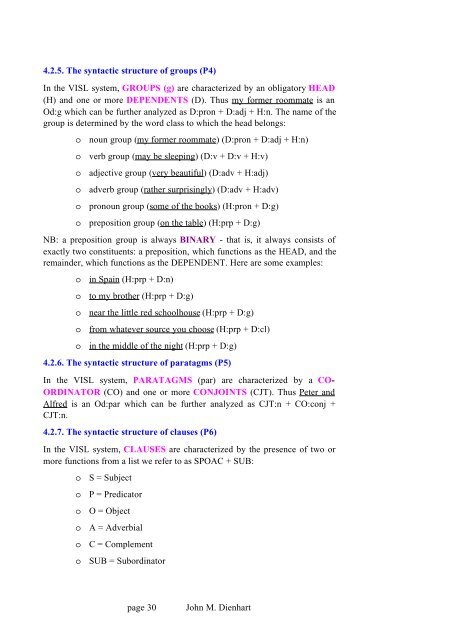Download - VISL
Download - VISL
Download - VISL
You also want an ePaper? Increase the reach of your titles
YUMPU automatically turns print PDFs into web optimized ePapers that Google loves.
4.2.5. The syntactic structure of groups (P4)<br />
In the <strong>VISL</strong> system, GROUPS (g) are characterized by an obligatory HEAD<br />
(H) and one or more DEPENDENTS (D). Thus my former roommate is an<br />
Od:g which can be further analyzed as D:pron + D:adj + H:n. The name of the<br />
group is determined by the word class to which the head belongs:<br />
o<br />
o<br />
o<br />
o<br />
o<br />
o<br />
noun group (my former roommate) (D:pron + D:adj + H:n)<br />
verb group (may be sleeping) (D:v + D:v + H:v)<br />
adjective group (very beautiful) (D:adv + H:adj)<br />
adverb group (rather surprisingly) (D:adv + H:adv)<br />
pronoun group (some of the books) (H:pron + D:g)<br />
preposition group (on the table) (H:prp + D:g)<br />
NB: a preposition group is always BINARY - that is, it always consists of<br />
exactly two constituents: a preposition, which functions as the HEAD, and the<br />
remainder, which functions as the DEPENDENT. Here are some examples:<br />
o<br />
o<br />
o<br />
o<br />
o<br />
in Spain (H:prp + D:n)<br />
to my brother (H:prp + D:g)<br />
near the little red schoolhouse (H:prp + D:g)<br />
from whatever source you choose (H:prp + D:cl)<br />
in the middle of the night (H:prp + D:g)<br />
4.2.6. The syntactic structure of paratagms (P5)<br />
In the <strong>VISL</strong> system, PARATAGMS (par) are characterized by a CO-<br />
ORDINATOR (CO) and one or more CONJOINTS (CJT). Thus Peter and<br />
Alfred is an Od:par which can be further analyzed as CJT:n + CO:conj +<br />
CJT:n.<br />
4.2.7. The syntactic structure of clauses (P6)<br />
In the <strong>VISL</strong> system, CLAUSES are characterized by the presence of two or<br />
more functions from a list we refer to as SPOAC + SUB:<br />
o<br />
o<br />
o<br />
o<br />
o<br />
o<br />
S = Subject<br />
P = Predicator<br />
O = Object<br />
A = Adverbial<br />
C = Complement<br />
SUB = Subordinator<br />
page 30<br />
John M. Dienhart
















